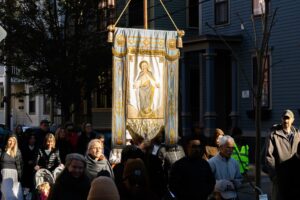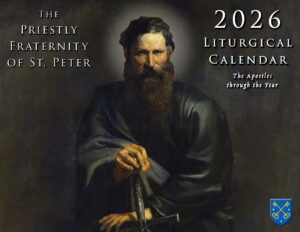Blessing of Processional Banners
by Fr. William Rock, FSSP

In the beginning of April 2025, I was contacted concerning how to properly decline a Latin title of Our Lady for use in the blessing of a processional banner. I had never heard of this blessing before and, after providing feedback about the Latin, asked where the blessing is found. It turns out that the blessing is contained in the standard Roman Ritual. On the following Holy Thursday, as the parish was preparing for the evening’s liturgy, I was asked if the organizational banners which would be used in the Eucharistic procession should be blessed/if I was willing to bless them. I jumped at the chance to use the blessing about which I had recently learned. The hand of Providence, perhaps, can be seen in all of this.
The following is a translation of the blessing of a processional banner for any congregation:
℣. Our help is in the Name of the Lord.
℟. Who made heaven and earth.℣. The Lord be with you.
℟. And with your spirit.Let us pray.
Lord Jesus Christ, Whose Church is like a well ordered battle-array, bless ✠ this banner; and grant that all who fight under this standard for Your sake, O Lord God, may by the prayers of Blessed N. overcome their visible and invisible enemies in this life, and after this victory come as conquerors to the kingdom of heaven. We ask this through You, Jesus Christ, Who live and reign with God the Father and the Holy Ghost forever and ever.℟. Amen.
The banner is sprinkled with holy water.1
It was very common in the past for different congregations (be they societies, confraternities, sodalities, guilds, religious associations, Tertiaries, and the like) to have their own processional banners upon which was emblazoned the image of their respective heavenly patron or patroness. It would be this patron or patroness who would be named while the blessing was being imparted. Even today, these banners can lead members of their respective congregations during the various processions of the year, such as on the Purification, Palm Sunday, Holy Thursday, the Rogation Days, Corpus Christi, and any local processions. In these processions, the banners and members, in their dress and insignia, precede the processional cross,2 though the laity usually follow behind the sacred ministers. When not in use, the banners may be displayed near a shrine or side altar in the local church dedicated to their patron or patroness, if one be present.

Both in the title and the text, the Latin for banner is “vexillum,” the same word applied to the Cross in the famous processional hymn of Venantius Fortunatus, Bishop of Poitiers, [† c. A.D. 600], the Vexilla regis prodeunt, sung during Passiontide, and also in the Secrets of the Masses of the Finding (3 May) and Exaltation (14 September) of the True Cross and in the Collect of the Votive Mass of the Holy Cross (outside of Paschaltide). While the word can be translated simply as “banner,” it should be understood that “the vexillum was the old Roman cavalry standard, which, after Constantine, was surmounted by a Cross instead of by the Roman eagle.”3 The specific use of this word, and its application to a processional banner, explains the militaristic tone of the blessing which begins by implying that the Church here below is a Church Militant.
The members of the congregation, as the blessing explains, are expected to fight against their visible and invisible enemies, that is, against the false maxims of this fallen world, against the sinful concupiscence of the flesh, and against the snares and traps of the devil and his fallen angels, using the weapons of prayer, fasting, and almsdeeds. By so doing, aided by the intercession of their heavenly patron(ess), it is hoped that they will receive an eternal reward as victors and conquerors.
In conclusion, dear reader, if your parish has congregational banners, it might be worthwhile for the leads of the different organizations to arrange to have them blessed if they are not so already and to promote their use, and the attendance of the members, at the various processions of the year. If your parish congregations do not have such banners, perhaps this article will serve as the impetus for their procuring of them.
Fr. William Rock, FSSP was ordained in the fall of 2019 and is currently assigned to St. Stanislaus Parish in Nashua, NH.
In support of the causes of Blessed Maria Cristina, Queen, and Servant of God Francesco II, King
- Rituale Romanum [1957], Titulus IX – Caput 8, 3; English adapted from the Weller translation provided online by EWTN (2, VII, 24).
- Britt, Matthew. The Hymns of The Breviary and Missal. (New York: Benziger Brothers, 1936), p. 124.
- Fortescue, A., O’Connell, J.B., & Reid, A. The Ceremonies of the Roman Rite Described (15th ed.). (New York: Burn & Oates, 2009), p. 390, n. 42.
July 7, 2025









